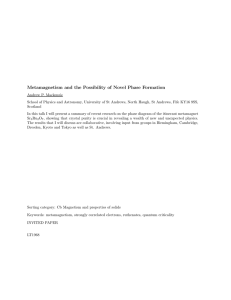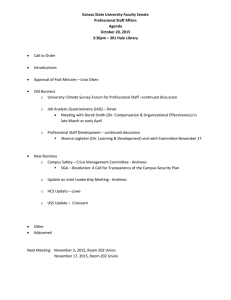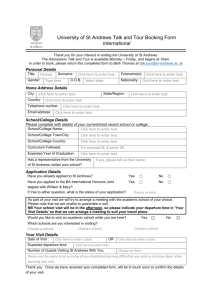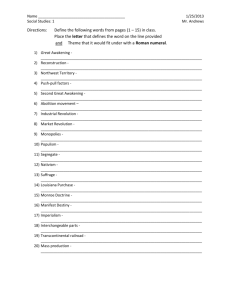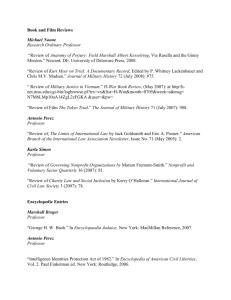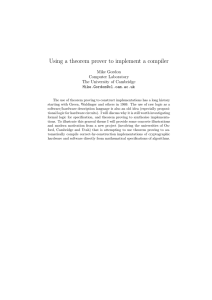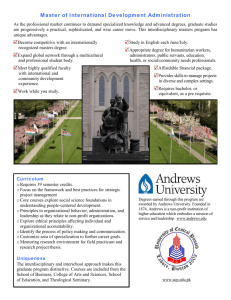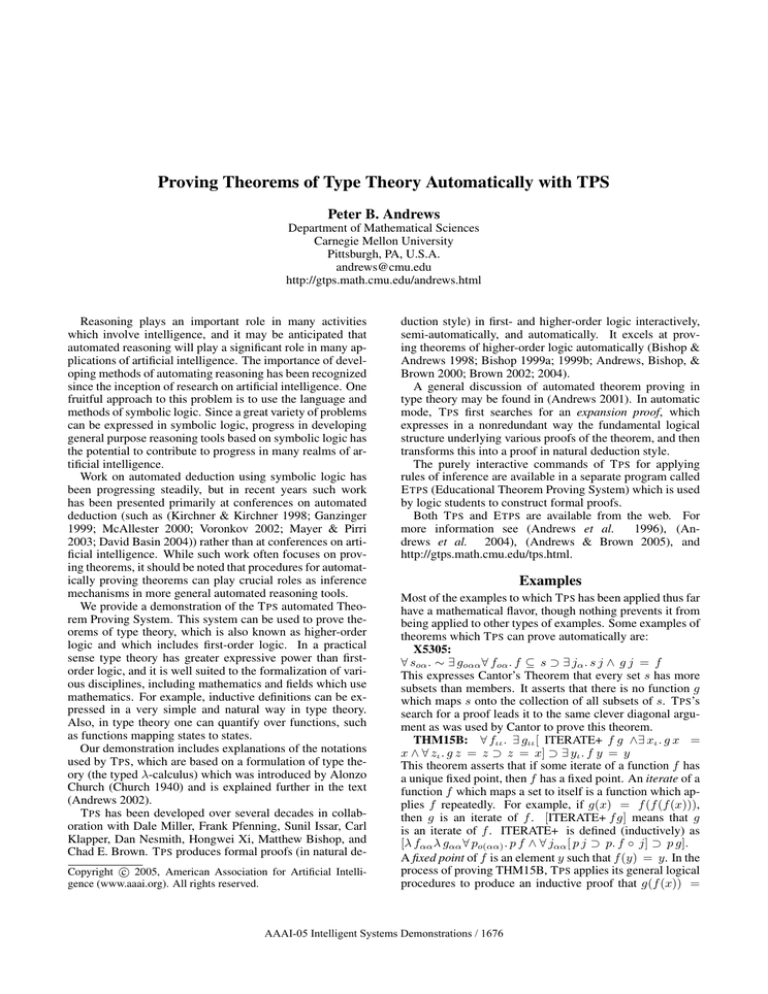
Proving Theorems of Type Theory Automatically with TPS
Peter B. Andrews
Department of Mathematical Sciences
Carnegie Mellon University
Pittsburgh, PA, U.S.A.
andrews@cmu.edu
http://gtps.math.cmu.edu/andrews.html
Reasoning plays an important role in many activities
which involve intelligence, and it may be anticipated that
automated reasoning will play a significant role in many applications of artificial intelligence. The importance of developing methods of automating reasoning has been recognized
since the inception of research on artificial intelligence. One
fruitful approach to this problem is to use the language and
methods of symbolic logic. Since a great variety of problems
can be expressed in symbolic logic, progress in developing
general purpose reasoning tools based on symbolic logic has
the potential to contribute to progress in many realms of artificial intelligence.
Work on automated deduction using symbolic logic has
been progressing steadily, but in recent years such work
has been presented primarily at conferences on automated
deduction (such as (Kirchner & Kirchner 1998; Ganzinger
1999; McAllester 2000; Voronkov 2002; Mayer & Pirri
2003; David Basin 2004)) rather than at conferences on artificial intelligence. While such work often focuses on proving theorems, it should be noted that procedures for automatically proving theorems can play crucial roles as inference
mechanisms in more general automated reasoning tools.
We provide a demonstration of the T PS automated Theorem Proving System. This system can be used to prove theorems of type theory, which is also known as higher-order
logic and which includes first-order logic. In a practical
sense type theory has greater expressive power than firstorder logic, and it is well suited to the formalization of various disciplines, including mathematics and fields which use
mathematics. For example, inductive definitions can be expressed in a very simple and natural way in type theory.
Also, in type theory one can quantify over functions, such
as functions mapping states to states.
Our demonstration includes explanations of the notations
used by T PS, which are based on a formulation of type theory (the typed λ-calculus) which was introduced by Alonzo
Church (Church 1940) and is explained further in the text
(Andrews 2002).
T PS has been developed over several decades in collaboration with Dale Miller, Frank Pfenning, Sunil Issar, Carl
Klapper, Dan Nesmith, Hongwei Xi, Matthew Bishop, and
Chad E. Brown. T PS produces formal proofs (in natural dec 2005, American Association for Artificial IntelliCopyright °
gence (www.aaai.org). All rights reserved.
duction style) in first- and higher-order logic interactively,
semi-automatically, and automatically. It excels at proving theorems of higher-order logic automatically (Bishop &
Andrews 1998; Bishop 1999a; 1999b; Andrews, Bishop, &
Brown 2000; Brown 2002; 2004).
A general discussion of automated theorem proving in
type theory may be found in (Andrews 2001). In automatic
mode, T PS first searches for an expansion proof, which
expresses in a nonredundant way the fundamental logical
structure underlying various proofs of the theorem, and then
transforms this into a proof in natural deduction style.
The purely interactive commands of T PS for applying
rules of inference are available in a separate program called
E TPS (Educational Theorem Proving System) which is used
by logic students to construct formal proofs.
Both T PS and E TPS are available from the web. For
more information see (Andrews et al.
1996), (Andrews et al. 2004), (Andrews & Brown 2005), and
http://gtps.math.cmu.edu/tps.html.
Examples
Most of the examples to which T PS has been applied thus far
have a mathematical flavor, though nothing prevents it from
being applied to other types of examples. Some examples of
theorems which T PS can prove automatically are:
X5305:
∀ soα . ∼ ∃ goαα ∀ foα . f ⊆ s ⊃ ∃ jα . s j ∧ g j = f
This expresses Cantor’s Theorem that every set s has more
subsets than members. It asserts that there is no function g
which maps s onto the collection of all subsets of s. T PS’s
search for a proof leads it to the same clever diagonal argument as was used by Cantor to prove this theorem.
THM15B: ∀ fιι . ∃ gιι [ ITERATE+ f g ∧∃ xι . g x =
x ∧ ∀ zι . g z = z ⊃ z = x] ⊃ ∃ yι . f y = y
This theorem asserts that if some iterate of a function f has
a unique fixed point, then f has a fixed point. An iterate of a
function f which maps a set to itself is a function which applies f repeatedly. For example, if g(x) = f (f (f (x))),
then g is an iterate of f . [ITERATE+ f g] means that g
is an iterate of f . ITERATE+ is defined (inductively) as
[λ fαα λ gαα ∀ po(αα) . p f ∧ ∀ jαα [ p j ⊃ p. f ◦ j] ⊃ p g].
A fixed point of f is an element y such that f (y) = y. In the
process of proving THM15B, T PS applies its general logical
procedures to produce an inductive proof that g(f (x)) =
AAAI-05 Intelligent Systems Demonstrations / 1676
f (g(x)) when g is an iterate of f . No knowledge or heuristics about induction or iterates are built into T PS except for
the inductive definition of the set of iterates. T PS uses this
result to conclude that if x is the unique fixed point of g (so
g(x) = x), then g(f (x)) = f (g(x)) = f (x), so f (x) is
also a fixed point of g, so f (x) = x, and f has a fixed point.
THM136:
∀ roαα TRANSITIVE [TRANSITIVE-CLOSURE r]
This asserts that the transitive closure of a relation is transitive. TRANSITIVE is defined as
[λ Roαα ∀ Xα ∀ Yα ∀ Zα . R X Y ∧ R Y Z ⊃ R X Z],
and TRANSITIVE-CLOSURE is defined as
[λ roαα λ xα λ yα ∀ poαα . r ⊆ p∧TRANSITIVE p ⊃ p x y].
When searching for proofs of theorems which contain definitions (abbreviations), it is a significant problem to decide
which instances of the definitions to instantiate (expand).
Often, one needs to instantiate some, but not all, of them,
and if one does instantiate all of them, one can cause the
search space to expand in a very undesirable way. This theorem provides an example of this problem. T PS finds a proof
for this theorem by using a technique called dual instantiation (Bishop & Andrews 1998). It involves making each
instance of a definition accessible to the search procedure
in both its instantiated and its uninstantiated form, and letting the search procedure decide which to use, with a bias in
favor of the uninstantiated form.
THM145B: [TRANSITIVE ≤] ∧∀ soα [ ∀ zα [ s z ⊃
z ≤ Uα(oα) s] ∧∀ jα .∀ kα [ s k ⊃ k ≤ j] ⊃ U s ≤ j]
⊃ ∀ fαα .∀ xα ∀ yα [ x ≤ y ⊃ f x ≤ f y] ⊃ ∃ wα . w ≤
fw∧ fw≤ w
This asserts that in a complete lattice (with [Uα(oα) soα ] as
lub soα ), every monotone function has a fixed point. T PS
finds the fixed point [ Uα(oα) .λ uα . u ≤ fαα u].
THM587:
IND ∧ PLUS-INDEQS 0ι Sιι
⊃ ∀ xι ∀ yι .[ x + y] + y = x + [ y + y]
IND (the principle of induction) is defined as
∀ poι . p 0ι ∧ ∀ xι [ p x ⊃ p. Sιι x] ⊃ ∀ x p x, and
PLUS-INDEQS (the inductive definition of +) is defined as λ 0ι λ Sιι .∀ nι [ n + 0 = n] ∧ ∀ n∀ mι . n + S m =
S[ n + m]. It is natural and appropriate to try to prove
this by induction, but neither induction on x nor induction
on y works without some auxiliary lemmas. T PS decides
to derive ∀ uι .[ xι + yι ] + u = x + [ y + u] from the
hypotheses by induction on u, and then derives the desired
conclusion from this.
Acknowledgements
This material is based on work supported by NSF grants
MCS81-02870, DCR-8402532, CCR-8702699, CCR9002546, CCR-9201893, CCR-9502878, CCR-9624683,
CCR-9732312, and CCR-0097179.
References
Andrews, P. B., and Brown, C. E. 2005. Tps: A hybrid
automatic-interactive system for developing proofs. Journal of Applied Logic 3. to appear.
Andrews, P. B.; Bishop, M.; Issar, S.; Nesmith, D.; Pfenning, F.; and Xi, H. 1996. TPS: A theorem proving system
for classical type theory. Journal of Automated Reasoning
16:321–353.
Andrews, P. B.; Brown, C. E.; Pfenning, F.; Bishop, M.;
Issar, S.; and Xi, H. 2004. Etps: A system to help students write formal proofs. Journal of Automated Reasoning 32:75–92.
Andrews, P. B.; Bishop, M.; and Brown, C. E. 2000. System description: Tps: A theorem proving system for type
theory. In McAllester (2000), 164–169.
Andrews, P. B. 2001. Classical type theory. In Robinson,
A., and Voronkov, A., eds., Handbook of Automated Reasoning, volume 2. Elsevier Science. chapter 15, 965–1007.
Andrews, P. B. 2002. An Introduction to Mathematical
Logic and Type Theory: To Truth Through Proof. Kluwer
Academic Publishers, second edition.
Bishop, M., and Andrews, P. B. 1998. Selectively instantiating definitions. In Kirchner and Kirchner (1998), 365–
380.
Bishop, M. 1999a. A breadth-first strategy for mating
search. In Ganzinger (1999), 359–373.
Bishop, M. 1999b. Mating Search Without Path Enumeration. Ph.D. Dissertation, Department of Mathematical Sciences, Carnegie Mellon University. Department of Mathematical Sciences Research Report No. 99–223.
Brown, C. E. 2002. Solving for set variables in higherorder theorem proving. In Voronkov (2002), 408–422.
Brown, C. E. 2004. Set Comprehension in Church’s Type
Theory. Ph.D. Dissertation, Department of Mathematical
Sciences, Carnegie Mellon University.
Church, A. 1940. A formulation of the simple theory of
types. Journal of Symbolic Logic 5:56–68.
David Basin, M. R., ed. 2004. Automated Reasoning, Second International Joint Conference, IJCAR 2004, volume
3097 of Lecture Notes in Artificial Intelligence. Cork, Ireland: Springer-Verlag.
Ganzinger, H., ed. 1999. Proceedings of the 16th International Conference on Automated Deduction, volume 1632
of Lecture Notes in Artificial Intelligence. Trento, Italy:
Springer-Verlag.
Kirchner, C., and Kirchner, H., eds. 1998. Proceedings
of the 15th International Conference on Automated Deduction, volume 1421 of Lecture Notes in Artificial Intelligence. Lindau, Germany: Springer-Verlag.
Mayer, M. C., and Pirri, F., eds. 2003. Automated
Reasoning with Analytic Tableaux and Related Methods.
(TABLEAUX 2003), volume 2796 of Lecture Notes in Artificial Intelligence. Rome, Italy: Springer-Verlag.
McAllester, D., ed. 2000. Proceedings of the 17th International Conference on Automated Deduction, volume 1831
of Lecture Notes in Artificial Intelligence. Pittsburgh, PA,
USA: Springer-Verlag.
Voronkov, A., ed. 2002. Proceedings of the 18th International Conference on Automated Deduction, volume 2392
of Lecture Notes in Artificial Intelligence. Copenhagen,
Denmark: Springer-Verlag.
AAAI-05 Intelligent Systems Demonstrations / 1677

